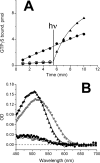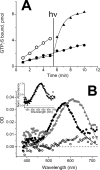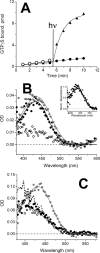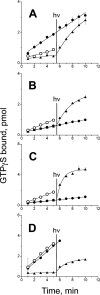The action of 11-cis-retinol on cone opsins and intact cone photoreceptors
- PMID: 19386593
- PMCID: PMC2713570
- DOI: 10.1074/jbc.M109.004697
The action of 11-cis-retinol on cone opsins and intact cone photoreceptors
Abstract
11-cis-retinol has previously been shown in physiological experiments to promote dark adaptation and recovery of photoresponsiveness of bleached salamander red cones but not of bleached salamander red rods. The purpose of this study was to evaluate the direct interaction of 11-cis-retinol with expressed human and salamander cone opsins, and to determine by microspectrophotometry pigment formation in isolated salamander photoreceptors. We show here in a cell-free system using incorporation of radioactive guanosine 5'-3-O-(thio)triphosphate into transducin as an index of activity, that 11-cis-retinol inactivates expressed salamander cone opsins, acting an inverse agonist. Similar results were obtained with expressed human red and green opsins. 11-cis-retinol had no significant effect on the activity of human blue cone opsin. In contrast, 11-cis-retinol activates the expressed salamander and human red rod opsins, acting as an agonist. Using microspectrophotometry of salamander cone photoreceptors before and after bleaching and following subsequent treatment with 11-cis-retinol, we show that 11-cis-retinol promotes pigment formation. Pigment was not formed in salamander red rods or green rods (containing the same opsin as blue cones) treated under the same conditions. These results demonstrate that 11-cis-retinol is not a useful substrate for rod photoreceptors although it is for cone photoreceptors. These data support the premise that rods and cones have mechanisms for handling retinoids and regenerating visual pigment that are specific to photoreceptor type. These mechanisms are critical to providing regenerated pigments in a time scale required for the function of these two types of photoreceptors.
Figures





Similar articles
-
cis Retinol oxidation regulates photoreceptor access to the retina visual cycle and cone pigment regeneration.J Physiol. 2016 Nov 15;594(22):6753-6765. doi: 10.1113/JP272831. Epub 2016 Aug 2. J Physiol. 2016. PMID: 27385534 Free PMC article.
-
Differences in the pharmacological activation of visual opsins.Vis Neurosci. 2006 Nov-Dec;23(6):899-908. doi: 10.1017/S0952523806230256. Vis Neurosci. 2006. PMID: 17266782
-
Effect of 11-cis 13-demethylretinal on phototransduction in bleach-adapted rod and cone photoreceptors.J Gen Physiol. 2000 Aug;116(2):283-97. doi: 10.1085/jgp.116.2.283. J Gen Physiol. 2000. PMID: 10919871 Free PMC article.
-
The visual cycle of the cone photoreceptors of the retina.Nutr Rev. 2004 Jul;62(7 Pt 1):283-6. doi: 10.1111/j.1753-4887.2004.tb00053.x. Nutr Rev. 2004. PMID: 15384919 Review.
-
Vitamin A1/A2 chromophore exchange: Its role in spectral tuning and visual plasticity.Dev Biol. 2021 Jul;475:145-155. doi: 10.1016/j.ydbio.2021.03.002. Epub 2021 Mar 6. Dev Biol. 2021. PMID: 33684435 Free PMC article. Review.
Cited by
-
Vitamin A activates rhodopsin and sensitizes it to ultraviolet light.Vis Neurosci. 2011 Nov;28(6):485-97. doi: 10.1017/S0952523811000423. Vis Neurosci. 2011. PMID: 22192505 Free PMC article.
-
Retinal Attachment Instability Is Diversified among Mammalian Melanopsins.J Biol Chem. 2015 Nov 6;290(45):27176-27187. doi: 10.1074/jbc.M115.666305. Epub 2015 Sep 28. J Biol Chem. 2015. PMID: 26416885 Free PMC article.
-
Regeneration of photopigment is enhanced in mouse cone photoreceptors expressing RPE65 protein.J Neurosci. 2011 Jul 13;31(28):10403-11. doi: 10.1523/JNEUROSCI.0182-11.2011. J Neurosci. 2011. PMID: 21753017 Free PMC article.
-
cis Retinol oxidation regulates photoreceptor access to the retina visual cycle and cone pigment regeneration.J Physiol. 2016 Nov 15;594(22):6753-6765. doi: 10.1113/JP272831. Epub 2016 Aug 2. J Physiol. 2016. PMID: 27385534 Free PMC article.
-
Rhodopsin in the rod surface membrane regenerates more rapidly than bulk rhodopsin in the disc membranes in vivo.J Physiol. 2014 Jul 1;592(13):2785-97. doi: 10.1113/jphysiol.2014.272518. Epub 2014 May 6. J Physiol. 2014. PMID: 24801306 Free PMC article.
References
-
- Rushton W. A. H., Henry G. H. ( 1968) Vision Res. 8, 617– 631 - PubMed
-
- Burns M. E., Arshavsky V. Y. ( 2005) Neuron 48, 387– 401 - PubMed
-
- McBee J. K., Palczewski K., Baehr W., Pepperberg D. R. ( 2001) Prog. Retinal Eye Res. 20, 469– 529 - PubMed
-
- Lamb T. D., Pugh E. N., Jr. ( 2004) Prog. Retin. Eye Res. 23, 307– 380 - PubMed
Publication types
MeSH terms
Substances
Grants and funding
LinkOut - more resources
Full Text Sources
Medical

